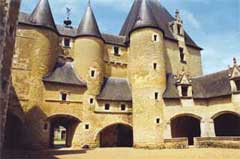Round Keep Castles
The round keep or Juliet, is the typical castle of the beginning of the Early English period. It succeeded the square and shell keeps during the long reign of Henry II. This form was already known in the previous era, as Conisborough is Norman.

Round Keep Castles:
The Great Keep at Coucy
The round keep is more closely related to the square keep than to the shell keep. It is in fact a cheaper and less commodious variety of the square keep, losing due to the limitations implied by the round plan, but gaining immensely in the passive strength and in the possibility of using the domed vault instead of timber as a roof. The limitations in respect of accommodation mattered less, as most of the castles built in the period had separate residential buildings, and the round keep was needed only for defensive purposes.
The round keep varied in size from the great towers of Conisborough and Pembroke, almost rivaling Rochester and Hedingham in dignity, to that of Usk, little more than a mural drum tower. A usual internal diameter is about 20 feet. That at Conisborough is 25 feet at the main floor level, and the exceptional example at Odiham 38 feet. Some small castles, as Roche, Dolbadarn, and Longtown, consisted of Juliet, and little if anything beside. In plan, they are almost always circular, but the Odiham keep is octagonal, and that at Orford is multiangular, and complicated by the addition of three flanking towers.
In France, where round keeps were numerous and reached a high degree of size and magnificence, the lobed or foliated plan was seen quite often. It is also employed in England, at Warwick.
The position of the round keep could be either upon, or within the enceinte, the normal position of towers of this class being central, as at Skenfrith. At Conisborough it is situated upon the curtain wall, but its projection is wholly within the enclosure. At Usk, the tower has direct communication with the rampart walk. The tower at Tretower, Brecknock, has a unique position in the middle of a gutted or unfinished Norman rectangular keep.
Most of the round keep castles examples stand on natural foundations, whether on the level or on rocky prominences. Skenfrith, where the site is swampy, is raised upon a low mound of about six feet in height, but Caldicott presents the only instance of an artificial mound of any importance crowned by one of these towers, and there the foundations are carried down the natural surface.
Each tower contained a basement for stores, and two, three, or four floors above. The basement was generally vaulted, the upper floors were of wood. At Pembroke the roof is covered with a domed vault, and this may have been the case in other instances. The upper rooms usually possess fireplaces, and there is sometimes gardrobe accommodation. At Longtown the gardrobe is corbelled out clear of the wall. The staircases, where present, are curved flights in the thickness of the wall, which is always considerable. But at Usk there is a winding stair up to the third floor, and a wall staircase to the fourth floor and battlements.
A great and strong round keep is the Wakefield Tower in London, 50 feet in diameter, with walls 13 feet 6 inches in thickness at the base. It was originally of three stages in height, with an elevation of 70 to 80 feet. Its ground floor is circular, of late Norman workmanship. The upper. belonging to the Henry III period, contains a noble octagon room, 30 feet in diameter. The walls contain no passages or chambers, but there are a number of deep and broad recesses, one of which was an oratory. The tower owes its unusual size to its connection with the royal palace which adjoined it.
Later in date and different in character are the two towers at Warwick, the Guy’s and Caesar’s towers. They French rather than English in style. The Guy’s tower is twelve-sided in plan, about 38 feet in diameter. Caesar’s tower, at the south-east angle is the more imposing. It is placed on the summit of a rock which rises from the river Avon to a height of nearly 100 feet. It is divided internally into five stages with two staircases, and it carries on its summit a reservoir of water for the supply of the whole domestic wing of the castle. Both towers were built by Thomas Beauchamp the Second, towards the end of the 14th century.
The round keep of Coucy Château in Picardie, France, with a height of 55 m (some authors are claiming that its original height was about 200 feet), was the tallest keep ever.

